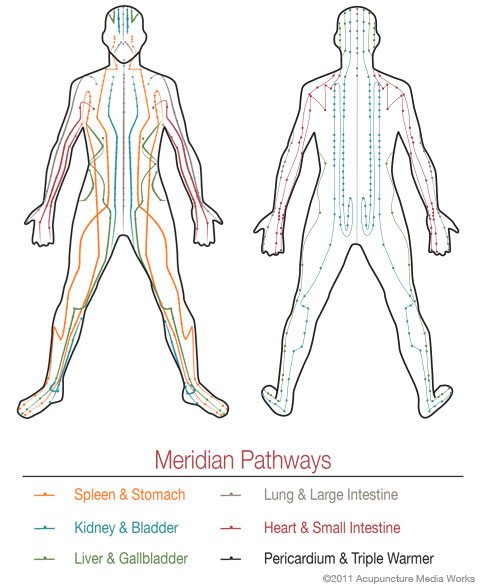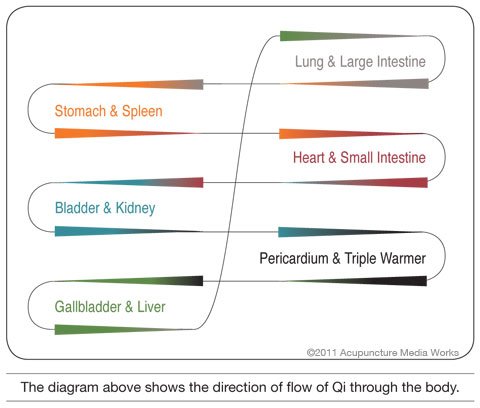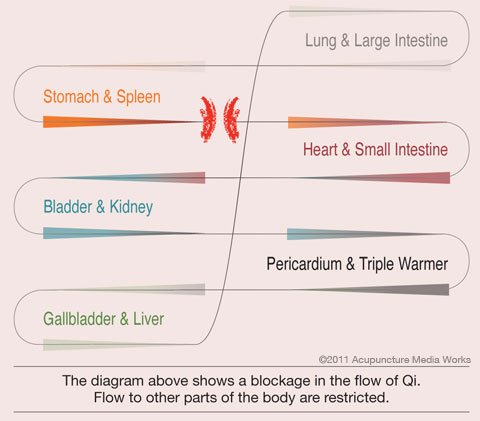Frequently Asked Questions
-
What is Acupuncture?
Acupuncture is an effective form of medical treatment that has evolved into a complete holistic health care system. Practitioners of acupuncture and Chinese medicine have used this noninvasive treatment method to help millions of people become well and stay well.
Acupuncture promotes natural healing. It can enhance recuperative power and immunity, support physical and emotional health, and improve overall function and well-being. It is a safe, painless and effective way to treat a wide variety of medical problems.

-
What is Qi?
At the core of this ancient medicine is the philosophy that Qi (pronounced “chee”), or vital energy, flows throughout the body. Qi animates the body and protects it from illness, pain and disease. A person's health is influenced by the quality, quantity and balance of Qi.

-
How does Qi move?
Qi flows through specific pathways called meridians. There are fourteen main meridians inside the body. The diagram to the left shows the meridian pathways in the body. Each of these is connected to specific organs and glands.
Meridian pathways are like rivers flowing inside the body. Where a river flows, it transports life-giving water that provides nourishment to the land, plants and people. Similarly, where meridian pathways flow, they bring life-giving Qi that provides nourishment to every cell, organ, gland, tissue and muscle in the body.

-
How is Qi disrupted?
An obstruction to the flow of Qi is like a dam. When Qi becomes backed up in one part of the body, the flow becomes restricted in other parts. This blockage of the flow of Qi can be detrimental to a person's health, cutting off vital nourishment to the body, organs and glands.
Physical and emotional trauma, stress, lack of exercise, overexertion, seasonal changes, poor diet, accidents, or excessive activity are among the many things that can influence the quality, quantity and balance of Qi.
Normally, when a blockage or imbalance occurs, the body easily bounces back, returning to a state of health and well-being. However, when this disruption is prolonged or excessive, or if the body is in a weakened state, illness, pain, or disease can set in.
Blockage of the flow of Qi can be detrimental to a person's health and leads to various signs and symptoms or health concerns.

FAQs
-
During the initial exam a full health history is taken. Questions are asked regarding health, symptoms and lifestyle. An appropriate physical exam is conducted, including pulse and tongue diagnosis.
Gathering this information enables the practitioner to effectively diagnose and detect any specific imbalances of Qi that may have contributed to a person's health problems. The practitioner can then create a well-structured treatment plan.
Once the imbalances of Qi are detected, an acupuncturist will place fine, sterile needles at specific acupoints along meridian pathways. This safe and painless insertion of the needles can unblock the obstruction and balance Qi where it has become unbalanced. Once this is done, Qi can freely circulate throughout the body, providing adequate nourishment to cells, organs, glands, tissues and muscles. This can eliminate pain and restore balance and harmony, as well as the body's ability to heal itself—ultimately leading to optimal health and well-being.
-
Yes, Acupuncture is used by millions of people every year. Acupuncturist are required to undergo extensive education, including a detailed study on the human anatomy, Clean Needle Technique, and over 350 hours in clinic. Acupuncturists also need to pass National Board Exams administered by the National Certification Commission for Acupuncture and Oriental Medicine (NCCAOM) and licensed by the practicing state. As required by law, pre-sterilized, disposable, single-use needles are used to ensure complete safety.
-
Cupping has been a part of Chinese Medicine for over 5000 years. It relieves aches and pains, relaxes tight muscles, improves circulation, expedites healing of injuries, detoxifies the body, helps with respiratory and digestive issues.
Chinese cupping therapy releases rigid soft tissue, drains excess fluids and toxins, loosens adhesions, lifts connective tissue, and brings fresh blood flow to stagnant skin and muscles.
The lifting action of Chinese cupping therapy creates space between the muscle and the fascia.
Muscles and connective tissue heal quicker with increased oxygen and blood flow to the area.
Moving and stationary cupping therapy is often done along the bladder channel on the back.
The bladder channel acupuncture points on the back are excellent locations for cupping therapy because they are known as back shu transport points that send blood and energy to corresponding internal organs.
The most common misunderstandings concerning cupping, is the misinterpretations of the marks that sometimes result. These marks are not bruises. Bruising is caused by impact trauma with the breakage of capillaries and a reactionary rush of fluids to the damaged location from the tissue injury. There is no compression in correctly performed cupping. Cupping therapy is excellent for conditions such as muscle sprains & strains, sciatica, back pain, and achy joints. Excellent for repetitive-motion, stress injuries.
-
· Electro-Acupuncture therapy (E-STIM) was first combined with acupuncture in China in the 1950s as adjunct anesthesia to reduce the amount of drug anesthetics required during surgery.
· Electro-Acupuncture therapy is safe for long-term use, and is now widely used in pain management and physical rehabilitation.
· Electro-Acupuncture therapy can also help treat anxiety, depression, and insomnia which often occur with chronic or severe injuries.
· A gentle electrical current using electrodes attached to acupuncture needles may be passed between acupoints in order to increase the effectiveness of removing obstruction from the channels.
· Mili-amp electro-stimulation interrupts pain/spasm cycles, and can facilitate the gains in joint range-of-motion crucial to physical rehabilitation.
· Electro-Acupuncture stimulates proprioceptive nerve fibers, resulting in muscle tension re-balancing and re-education of injured muscles. It normalizes local blood flow and lymph drainage.
· Electro-Acupuncture therapy provokes strong pain control responses through stimulation of the brain’s own opioid-neurotransmitters such as endorphins and enkephalins according to scientific research.
· E-Stim speeds up cell metabolism, stimulates tissue repair and tissue regeneration.
· Needles serve as electrodes to conduct current deep into tissues, resulting in better signal penetration and distribution, and more profound and long-lasting pain control than surface electrodes used in TENS (trans-cutaneous nerve stimulation).
-
Guasha is a Chinese therapy that involves a “scraping” technique of the skin. It can relieve facial stagnation, relax muscles, and break up scar tissue to improve circulation and help chronic pain.